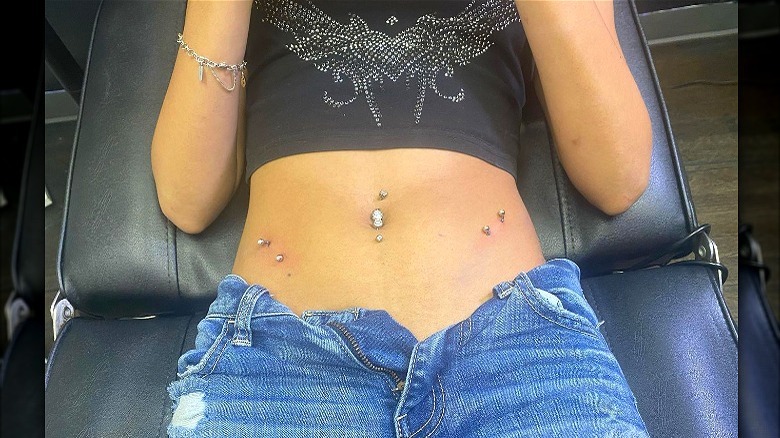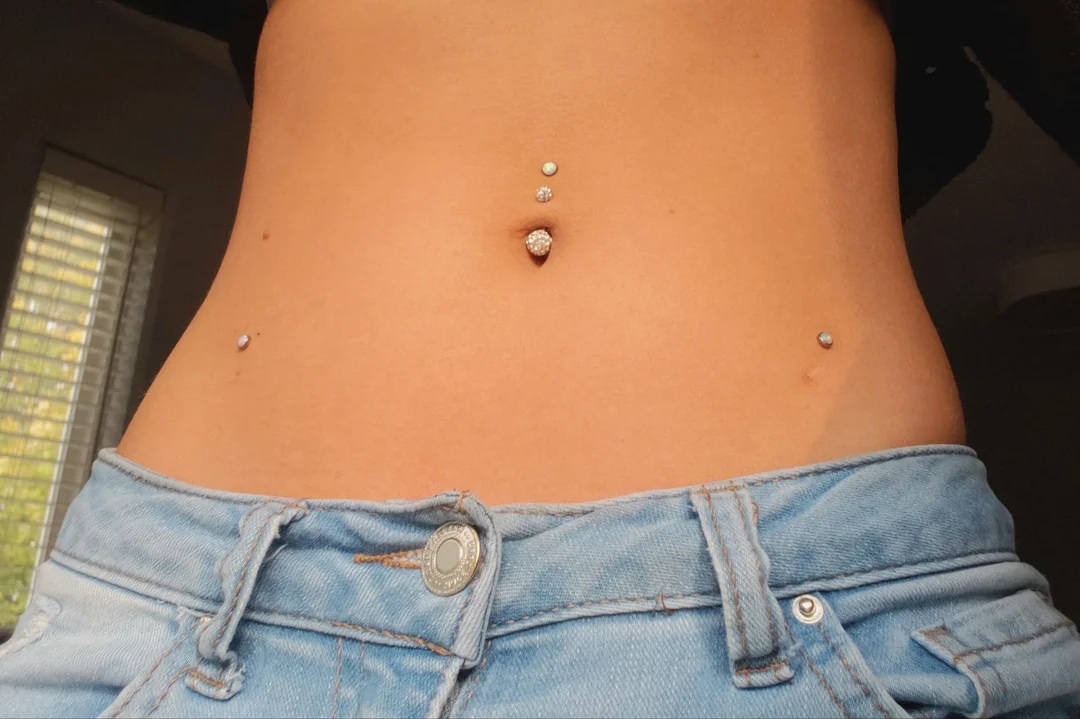There is a unique and captivating elegance to a piercing that complements the body’s natural contours. A single, glittering gem resting perfectly on the curve of the hip, catching the light with every movement—the hip dermal piercing is a statement of subtle sensuality and profound body confidence. Unlike traditional piercings that pass through an edge of tissue, a dermal appears to float effortlessly on the surface of the skin, creating a look that is both modern and mesmerising. It has become a key style for late 2025, a way to adorn and accentuate the body’s lines in a truly personal way.
However, the beautiful simplicity of a healed dermal piercing conceals a complex procedure and a significant commitment to aftercare. These are not “fit and forget” piercings. Their success and longevity are a direct result of three critical factors: expert placement, your unique anatomy, and your daily lifestyle. At PinkTatPier, we believe a consultation for a hip dermal piercing London is one of the most in-depth we offer. We recently worked with a client, Eva, who wanted a pair of symmetrical hip dermals as a personal celebration before a major life event. She had a vision of how they would look, but she also had many questions about their practicality.
Our lead specialist’s first conversation wasn’t about jewellery; it was about Eva’s life. We discussed the rise of her favourite jeans, the type of fabrics she wore, her preferred sleeping position, and her exercise routine. Using a sterile marker, we didn’t just find a placement that looked beautiful; we identified a “safe zone” on her hips that would minimise daily friction. We had a frank and honest conversation about the semi-permanent nature of all dermal piercings and the healing timeline. Eva left her consultation not just with a booking, but with a complete, realistic understanding of the partnership required between her and her piercing for it to thrive.
This in-depth, lifestyle-focused approach is the essence of a specialist service. This guide is an extension of that honest consultation. It is the most comprehensive resource for anyone considering this beautiful piercing, covering everything from the mechanics of a dermal anchor to the crucial long-term care required, and how to make an online reservation today for your own expert consultation with London’s best specialists.

hip dermal piercing
What is a Dermal Piercing? The Science of the Single-Point Anchor
Before exploring the specifics of the hip placement, it’s essential to understand the unique technology of a dermal piercing, also known as a microdermal or surface anchor.
How It Works: The Anchor and the Top
Unlike a traditional piercing which has a separate entry and exit point (like a lobe piercing), a dermal piercing is a single-point surface piercing. It is comprised of two distinct parts that work together:
- The Anchor (or Base): This is a small, flat piece of metal, typically with a series of holes in it, that is inserted underneath the dermal layer of your skin. It acts like a tiny, subcutaneous ship’s anchor.
- The Top (or End): This is the visible, decorative piece of jewellery—the gem, bead, or shape—which is internally threaded and screws into the post of the anchor.1
The magic of a dermal piercing lies in the healing process. Your body’s tissue is encouraged to grow through the holes in the anchor, effectively integrating it with your skin and securing it in place. This is what allows for the beautiful “floating” appearance on the surface.
The Concept of “Semi-Permanent”: An Honest Discussion
At PinkTatPier, we are committed to absolute transparency. All dermal piercings, regardless of placement, should be considered semi-permanent. While a perfectly placed dermal in a low-movement area can last for many, many years with ideal care, they have a naturally higher rate of rejection and migration than traditional piercings. Factors like lifestyle, friction, and even changes in your body can cause a dermal to reject over time.2 Understanding and accepting this from the beginning is key to a positive experience. A successful hip dermal piercing London is one that is enjoyed for as long as your body comfortably allows.
The Hip Placement: A Canvas of Unique Challenges and Considerations
The hips are a beautiful and popular placement for dermal piercings, creating a stunning accent that can be both hidden and revealed. However, this area of the body presents a unique set of challenges that must be expertly navigated.

hip dermal piercing
Enemy: Friction, Pressure, and Snagging
The hips are one of the highest-movement and highest-friction areas on the body. Think about your daily life:
- Clothing: The waistbands of jeans, trousers, skirts, and underwear sit directly on or rub against the hip area. Constant, even gentle, friction is the leading cause of irritation and rejection for hip dermals.
- Movement: Bending, sitting, and twisting all cause the skin on the hips to stretch and move, putting stress on the healing anchor.
- Sleeping: Many people sleep on their side, which puts hours of direct pressure on a hip piercing, severely impeding blood flow and hindering the healing process.
- Snagging: Loofahs in the shower, towels, and clothing are all major snagging hazards that can physically rip a dermal anchor out of the skin.
The Specialist’s Role: Strategic Placement for Maximum Longevity
Given these challenges, the role of London’s best specialists is to act as a strategist. Our placement process is a meticulous art form:
- The Lifestyle Consultation: We will have a detailed conversation with you about the cut of your clothes, your work, your hobbies, and how you sleep.
- Dynamic Marking: We will ask you to stand, sit, and bend while we find the “sweet spot.” We are looking for a placement that is not only aesthetically pleasing but also sits in a zone of minimal movement and is least likely to be irritated by your clothing.
- Anatomical Consideration: We assess the thickness and pliability of your skin and the underlying tissue. The anchor needs a stable foundation to heal into, away from prominent bone structures like the iliac crest (the top of the hip bone).
Our Studio’s Philosophy on Dermal Piercings:
“A dermal piercing is a promise of long-term care. Our job isn’t just to perform the 10-minute procedure; it’s to spend 30 minutes in consultation to give that piercing the best possible chance of lasting for years. We have to be part-piercer, part-stylist, and part-lifestyle coach. If we identify that a client’s lifestyle or anatomy presents an insurmountable risk of rejection for a hip dermal piercing London, it is our ethical duty to be honest about it and suggest a more viable, lower-friction placement. A happy client with a long-lasting piercing is always our ultimate goal.” – Our Lead Specialist at PinkTatPier
The Procedure, Healing, and Long-Term Care
The procedure for a dermal piercing is unique, and the healing journey requires a special kind of diligence.
The Dermal Anchor Procedure: A Specialist’s Technique
A dermal anchor is inserted using one of two professional methods: with a dermal punch or with a standard piercing needle.
- The Process: A small pocket is created under the skin.3 The anchor is then carefully inserted into this pocket and positioned so it sits perfectly flat. The decorative top is then screwed into place. The entire procedure is very quick and is often described as feeling like a brief, intense pressure.
- Our Technique: Our specialists are proficient in both techniques and will choose the method best suited to your skin type and the specific placement, always prioritising a clean, minimally invasive procedure.

hip dermal piercing
The Healing Journey: A Commitment to Care
Healing a dermal anchor is a long-term project. The initial healing phase is just the beginning.
Table: The Hip Dermal Piercing Healing & Long-Term Care Guide
| Timescale | What to Expect | Key Aftercare & Long-Term Management |
| Week 1-4 | Redness, swelling, and tenderness around the anchor are normal. Minor bruising may occur. The piercing is extremely fragile. | Keep the piercing covered with a small, breathable plaster for the first few days. Clean GENTLY twice daily with sterile saline. DO NOT touch or twist the top. Wear low-rise, loose-fitting clothing. |
| Month 2-3 | The piercing will appear healed on the surface. Redness and tenderness should be gone. However, the tissue is still healing and growing into the anchor underneath. | Continue to be extremely mindful of friction and snagging. This is the most common time for a piercing to be accidentally ripped out because it “feels” healed. Avoid sleeping on that side at all costs. |
| Month 3-6+ | The anchor is becoming more secure as the tissue integration completes. The piercing is now stable but not indestructible. | The piercing is now part of you, but it requires lifelong awareness. Continue to be cautious with clothing, towels, and high-impact activities. |
| Long-Term | Years | With perfect placement and care, your dermal can last for many years. |
Booking Your Dermal Piercing with London’s Best Specialists
A piercing with such specific challenges demands a specialist’s touch. At PinkTatPier, we combine our deep understanding of dermal piercing techniques with our client-focused, lifestyle-first approach.
Our Easy Online Reservation System
We believe that starting your journey should be simple and stress-free. Our easy online reservation system is available on our website 24/7. You can see our specialists’ availability, read about our services, and book online today for your consultation or piercing appointment. During the appointment, we will perform the full, in-depth consultation before proceeding to ensure a hip dermal piercing London is the right and safe choice for you.
Understanding the Pricing
The price for a hip dermal piercing reflects the specialist skill required and includes a high-quality, implant-grade titanium anchor and a basic decorative top. We have a wide selection of beautiful, interchangeable tops from the world’s best jewellery manufacturers available as an upgrade. Our pricing is transparent and can be viewed on our website.
Frequently Asked Questions (FAQ)
1. How painful is a hip dermal piercing?
The procedure itself is very quick. Most clients describe it as an intense, strange pressure sensation rather than a sharp pain, lasting for only a few seconds. The area will be tender and sore for the first week or two afterwards.
2. Will it leave a bad scar if it rejects or I have it removed?
If a dermal anchor is removed professionally as soon as it shows signs of rejection, the resulting scar is typically very small—a tiny dot or a very fine line that will fade over time. If it is left to reject completely or is traumatically ripped out, the scarring can be more significant. This is why professional removal is so important.
3. Can I change the top of my dermal myself?
Once your dermal is fully healed and mature (after 6+ months), it is possible to change the top yourself, but it must be done with extreme care. We highly recommend returning to our studio for your first few jewellery changes. Our specialists can change the top for you safely, without putting stress on the anchor, and can teach you the correct technique for doing so at home if you wish.

hip dermal piercing
Conclusion: A Statement of Body Confidence
The hip dermal piercing is a stunning way to adorn your body, a beautiful statement of confidence and personal style. It is a piercing that, more than any other, becomes a true partnership between you, your body, and your lifestyle. Its longevity is a testament not only to the skill of the piercer who places it but to the mindful care of the person who wears it. At PinkTatPier, we are here to provide the expert placement and the comprehensive education you need to give your piercing the very best chance of a long and beautiful life.
Your Next Step: Book Your Appointment Today
Are you ready to add this beautiful, unique piercing to your collection?
We invite you to take the first step with the confidence that you are choosing London’s best specialists. Use our easy online reservation system to book your appointment today. Let’s begin the conversation about your perfect hip dermal piercing.

